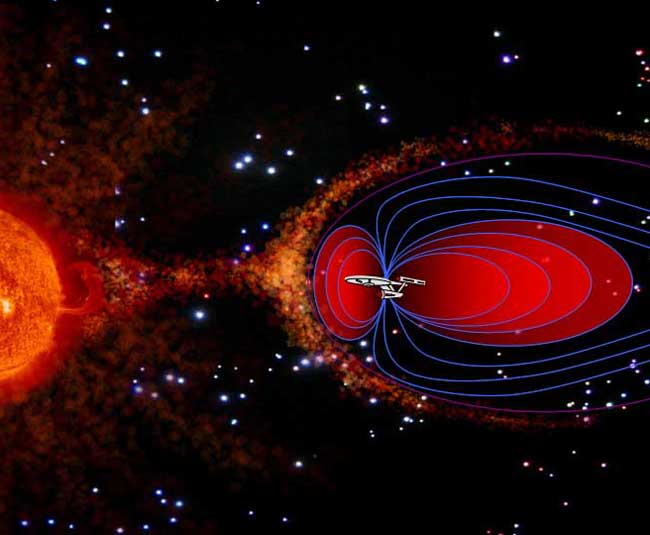Star Trek's Deflector Shield Envisioned for Mars Mission

One of the gravest dangers facing future astronauts traveling to Mars will be radiation in space: If the long trip doesn't kill them, cancer eventually could.
These threats can, however, be defeated. In Star Trek, a deflector shield surrounded the Starship Enterprise, and radiation bounced off it. Now tests show it's possible to create a real deflector shield that would have the same effect.
A new study found that a portable magnetic shield could be the key to protecting spacefarers during long-duration missions. A spaceship could be outfitted with a mini magnetosphere that would force the harmful charged particles in space to curve around the ship, rather than hitting the people inside.
While this idea has been tossed around since the 1960s, most experts thought it couldn't work because the magnetic field required to produce the effect would need to be too large. But a new test in the laboratory showed the process seems to work on a smaller scale, too.
Ruth Bamford of the Science and Technology Facilities Council's Rutherford Appleton Laboratory in England and her colleagues conducted tests on a miniature plasma field in the laboratory with similar properties to the wind of charged particles in space coming off of the sun (the source of much of the most harmful radiation to humans). When scientists set up a magnetic field inside this artificial solar wind, they found that the magnet created a bubble where no radiation could enter.
"We switched it on and there it was," Bamford told SPACE.com. "When we put the probe in we found out there were no particles inside the little bubble. If a spacecraft had been somewhere in this bubble it would have been protected from this beam. That was lovely to see."
Bamford detailed her findings in the Nov. 4 issue of the journal Plasma Physics and Controlled Fusion.
Get the Space.com Newsletter
Breaking space news, the latest updates on rocket launches, skywatching events and more!
The engineering details of how to use this technology on a spaceship must still be worked out. Moreover, the portable magnetic shield could only protect against particles coming from the solar wind, while other kinds of harmful particles, such as high energy gamma rays and X-rays, wouldn't be affected. Still, the technique is promising, since particles from the solar wind are extremely dangerous, especially during solar storms, when the wind plasma flares up and sends out surges of radiation.
"The protons [from the solar wind] apparently are the greatest concern for the health of the astronauts, because of their large concentration during storms, and because the particles are large enough to break DNA down," Bamford said. "In the early Apollo missions, the astronauts were very lucky to not be in space during a radiation burst. There was a storm between Apollo 16 and 17, which would have been fatal if the astronauts had been in space."
- Video - 2009 Star Trek Movie Trailer
- Image Gallery - NASA's New Spaceship: Going Back to the Moon
- Video - Sun Storms
Join our Space Forums to keep talking space on the latest missions, night sky and more! And if you have a news tip, correction or comment, let us know at: community@space.com.

Clara Moskowitz is a science and space writer who joined the Space.com team in 2008 and served as Assistant Managing Editor from 2011 to 2013. Clara has a bachelor's degree in astronomy and physics from Wesleyan University, and a graduate certificate in science writing from the University of California, Santa Cruz. She covers everything from astronomy to human spaceflight and once aced a NASTAR suborbital spaceflight training program for space missions. Clara is currently Associate Editor of Scientific American. To see her latest project is, follow Clara on Twitter.









